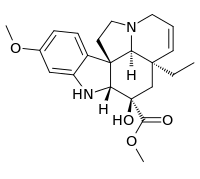3-Hydroxy-16-methoxy-2,3-dihydrotabersonine
 | |
| Names | |
|---|---|
| IUPAC name
Methyl (2β,3β,5α,12β,19α)-3-hydroxy-16-methoxy-6,7-didehydroaspidospermidine-3-carboxylate | |
| Identifiers | |
3D model (JSmol) |
|
| ChemSpider | |
PubChem CID |
|
| |
| |
| Properties | |
| C22H28N2O4 | |
| Molar mass | 384.48 g·mol−1 |
Except where otherwise noted, data are given for materials in their standard state (at 25 °C [77 °F], 100 kPa). | |
| Infobox references | |
3-Hydroxy-16-methoxy-2,3-dihydrotabersonine is a terpene indole alkaloid produced by Catharanthus roseus. The metabolite is a substrate for 3-hydroxy-16-methoxy-2,3-dihydrotabersonine N-methyltransferase (NMT) which transfers a methyl group to the nitrogen of the indole ring forming desacetoxyvindoline.[1] The enzyme catalyzing the formation of 3-hydroxy-16-methoxy-2,3-dihydrotabersonine from 16-methoxytabersonine is currently unknown, but is a result of hydration of the double bond connecting the 6 and 13 position carbons.[2] [3]
References
- ↑ Dethier and De Luca (1993) Partial purification of an N-methyltransferase involved in vindoline biosynthesis in Catharanthus roseus. Phytochemistry. 32(3). 673-678
- ↑ Liscombe, Usera and O’connor (2010) Homolog of tocopherol C methyltransferases catalyzes N methylation in anticancer alkaloid biosynthesis. Proceedings of the National Academy of Sciences. 107(44). 18793-18798
- ↑ O'connor and Maresh (2006) Chemistry and biology of monoterpene indole alkaloid biosynthesis. Natural Product Reports. 23(4). 532-547
This article is issued from
Wikipedia.
The text is licensed under Creative Commons - Attribution - Sharealike.
Additional terms may apply for the media files.